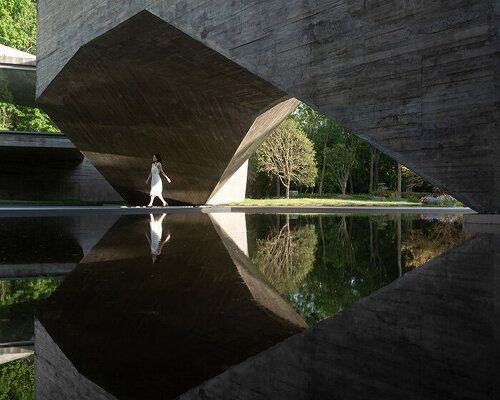Embedded in the Mountain Landscape: The Xiao Feng Art Museum by ZAO / standardarchitecture
Located at the foot of Daci Mountain in Hangzhou’s Xihu District, the Xiao Feng Art Museum by ZAO / standardarchitecture nestles quietly within a dense forest that opens onto a serene concrete courtyard. Conceived as a tribute to painters Xiao Feng and Song Ren, the museum unfolds as a continuous architectural loop. Its introverted design traces the contours of the surrounding hills through a thoughtful interplay of massing and voids.
From an aerial view, the museum appears as a gentle incision in the lush green terrain, threading between slopes like a line of thought carried through stone and shadow. Approached from a forest road, the entrance is revealed gradually. Visitors walk beneath a cantilevered bridge that frames a still courtyard central to the composition. This inner garden defines the museum’s orientation, with a reflective water surface mirroring the faceted underside of the concrete volumes above. The experience is enriched by the mountain’s canopy and the cool air rising from shaded voids beneath the structure.
Circulation as a Continuous Sequence
Inside, movement follows a circular route carefully curated by the architects at ZAO, mirroring the museum’s organic plan. Galleries expand and contract in rhythm as visitors progress, creating a dynamic flow of compression and release. Narrow passageways open into larger chambers, while gently sloped ramps connect shifting floor levels. These smooth transitions guide visitors through a changing sequence of light, texture, and framed views of the surrounding landscape.
The polygonal geometry allows galleries to project outward toward the courtyard. These sharp-edged volumes, equipped with large panoramic glazing, create visual exchanges between interior and exterior spaces. From inside, the forest serves as a suspended backdrop to the artworks. Conversely, from the courtyard, the galleries appear as floating rooms engaged in silent conversation.
Material Weight and Lightness
The entire structure is cast in concrete mixed with black ink pigment, imparting a muted, graphite-like tone that shifts under varying light conditions. The exposed texture bears the imprint of timber formwork, adding warmth to the otherwise monolithic material. The interplay between light and concrete defines the museum’s atmosphere: daylight filters through angular apertures, shifting across the rough walls, while at dusk, interior lighting casts faint glows into the courtyard.
This material uniformity deepens the museum’s relationship with its natural setting. Against the mountain’s lush greenery, the dark concrete reads as a man-made strata within a geological landscape. ZAO / standardarchitecture’s design remains grounded in this contrast, balancing solid and void, enclosure and view with careful precision.
A Modern Scholar’s Garden
Within the courtyard, mirrored pools and exposed concrete planes evoke the character of a traditional scholar’s garden, reinterpreted through modern form. The reflections add a sense of depth that doubles the surrounding environment, while the gentle sound of water softens the building’s angularity. Small trees planted within interstitial spaces brush their foliage against walls and glass, providing a living counterpart to the mineral composition.
As visitors move through the building, the galleries respond by expanding and contracting, offering a dynamic and immersive experience within this unique architectural setting.
https://www.designboom.com/architecture/zao-xiaofeng-art-museum-cluster-floating-galleries-hangzhou-china-10-29-2025/
